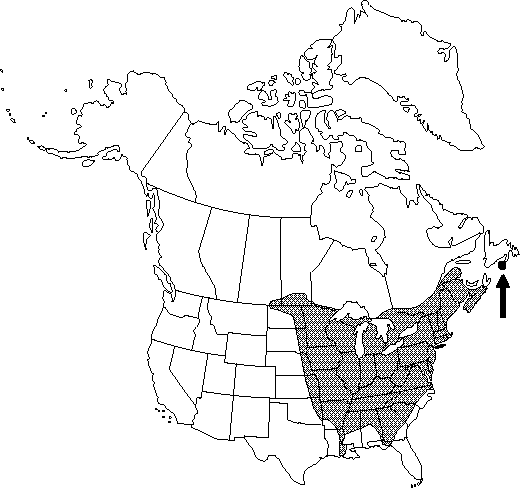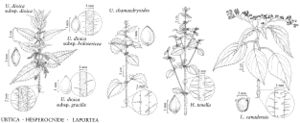Laportea canadensis
Ann. Sci. Nat., Bot., sér. 4, 1: 181. 1854.
Herbs, annual or perennial, rhizomatous, with tuberous roots, 3-15 dm, sparsely to densely covered with stinging hairs and nonglandular, nonstinging hairs, stipitate-glandular hairs absent. Leaf-blades narrowly to broadly ovate, 6-30 × 3-18 cm, base rounded, truncate, or broadly cuneate, not auriculate, margins regularly serrate, apex acuminate. Inflorescences with staminate and pistillate flowers in separate panicles, proximal panicles staminate, distal panicles pistillate. Staminate flowers ca. 1-1.5 mm across; tepals5, equal in length; stamens5, opposite tepals; filaments slightly longer than tepals. Pistillate flowers ca. 0.5 mm; tepals 2-4, appressed, inner pair as long as ovary; ovary compressed, nearly orbicular to crescent-shaped; style persistent, feathery, 2-3 mm or more. Achenes strongly compressed, ± orbicular, ca. 2-3 mm. 2n=26.
Phenology: Flowering spring–early fall.
Habitat: Rich, moist, deciduous forests, often along seepages and streams
Elevation: 0-2000 m
Distribution

St. Pierre and Miquelon, Man., N.B., N.S., Ont., Que., Sask., Ala., Ark., Conn., Del., D.C., Fla., Ga., Ill., Ind., Iowa, Kans., Ky., La., Maine, Md., Mass., Mich., Minn., Miss., Mo., Nebr., N.H., N.J., N.Y., N.C., N.Dak., Ohio, Okla., Pa., R.I., S.C., S.Dak., Tenn., Vt., Va., W.Va., Wis., Mexico
Discussion
Native Americans used Laportea canadensis to treat incontinence and tuberculosis, to counteract poison, as a love medicine, and to facilitate childbirth (D.E. Moerman 1986).
Selected References
None.
Lower Taxa
"equal" is not a number.
